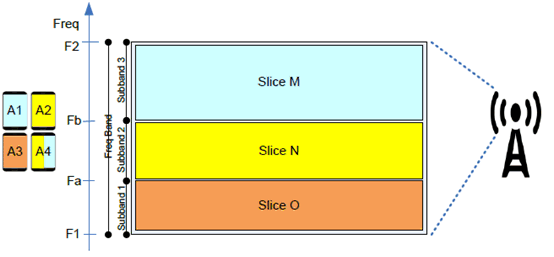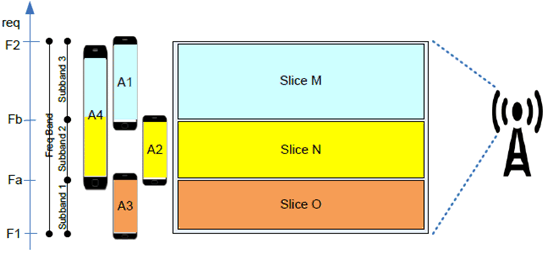Content for TR 22.835 Word version: 18.2.0
5.10 Isolation of resource for network slice
5.10.1 Description
5.10.2 Pre-conditions
5.10.3 Service Flows
5.10.4 Post-conditions
5.10.5 Existing features partly or fully covering the use case functionality
5.10.6 Potential New Requirements needed to support the use case
5.11 Interaction with Third party for network slice
5.11.1 Description
5.11.2 Pre-conditions
5.11.3 Service Flows
5.11.4 Post-conditions
5.11.5 Existing features partly or fully covering the use case functionality
5.11.6 Potential New Requirements needed to support the use case
...
...
5.10 Isolation of resource for network slice p. 27
5.10.1 Description p. 27
Due to various sources and ways to gain right to use specific frequency resources, even within a continuous frequency range, different blocks of frequency within the range can be restricted to different purposes.
Also, based on the requirements on the levels of isolation and security, access by a network slice beyond the authorized blocks should not occur, even if the frequency blocks are adjacent.
5.10.2 Pre-conditions p. 28
Figure 5.10.2-1 shows the use case scenario where frequency band are partitioned into multiple subbands.

In this figure, it is assumed that
-
Subscription:
- UE A1 and A4 have subscription to slice M, and this slice M is optimized e.g. for IoT type of application.
- UE A2 and A4 have subscription to slice N, and this slice N is optimized e.g. for eMBB type of application.
- UE A3 has subscription to slice O, and this slice O is optimized e.g. for URLLC. The users or application providers request isolation of radio resources used for this network slice.
-
Deployment:
- The cell is configured to use frequency band which is from F1 to F2.
- The frequency band is sub-divided into three subbands. The allocated frequency for the first subband spans from F1 to Fa. The allocated frequency for the second subband spans from Fa to Fb. The allocated frequency for the third subband spans from Fb to F2.
- The first subband is used for slice O. The second subband is used for slice N. The third subband is used for slice M. in addition, third subband can be used for common procedure, e.g. SIB.
5.10.3 Service Flows p. 28
Following is service flow for UE A1, A2, A3 and A4:
- After power-on, UE A1, A2, A3 and A4 camp on a cell, where the subscribed slices can be provided. Because the UEs are accessing the same cell supporting at least one of the subscribed network slices, there is no need for the UEs to move to other cells.
- When applications start, UE A1 transmits and receives data over Slice M, which is restricted to subband 3.
- When applications start, UE A2 transmits and receives data over Slice N, which is restricted to subband 2.
- When applications start, UE A3 transmits and receives data over Slice O, which is restricted to subband 1.
- When applications start, UE A4 transmits and receives data. For traffic configured to use Slice M, the transmission and reception is performed using radio resources within subband 3. For traffic configured to use Slice N, the transmission and reception is performed within radio resources within subband 2. Due to isolation requirement or service agreement for the network slice, traffic for Slice M is not transported over subband 2. Similarly, traffic for Slice N is not transported over subband 3.
- As demands for the network slice changes according to the number of UEs for the network slice or time of the day, the network adjusts the allowed frequency range of each network slice. There is no recognized impact to the user experience.
5.10.4 Post-conditions p. 29
Following Figure 5.10.4-1 shows the status at the end of service flow.
For the transport of user traffic, each UE may use different part of frequencies of the cells, which corresponds to the configured frequency range for each network slice.

5.10.5 Existing features partly or fully covering the use case functionality p. 29
Following service requirements are already supported by current specifications:
BWP (Bandwidth Part) operation defined in TS38.300 [4] does not provide a UE with the support for providing different network slices on different frequency bands, when the UE is authorized to use multiple network slices.
- 3GPP system shall provide means to support flexibility in configuring the allowed or restricted radio resources for a network slice.
- 3GPP system shall support for a network slice to use specific portion of the radio resources (e.g. frequency range) within a cell.
- 3GPP system shall be able to allow or disallow user traffic for a network slice to be multiplex with the user traffic for other network slice, based on the security and isolation requirement of the network slice.
5.10.6 Potential New Requirements needed to support the use case p. 29
Following new requirements can be derived from this use case:
[PR.5.10.6-1]
5G system shall be able to minimize service interruption when configured radio resource (e.g. frequency range) for a network slice changes.
5.11 Interaction with Third party for network slice p. 29
5.11.1 Description p. 29
A network slice can be provided and customized based on the request of customers. For example, an application provider may want a dedicated network slice for its application and may expand or decrease the capacity of the network slices based on the dynamic demand for the application.
In other scenario, the third party itself may get and have right to use a specific frequency band. For example, by applying for local spectrum license, third party itself may own the right to use some frequency band and this frequency band can be used for a network slice and UEs dedicated to this third party.
5.11.2 Pre-conditions p. 30
Application provider AP1 has a service agreement with operator OP1. With this service agreement, OP1 creates and runs a network slice NSz, which is dedicated for AP1. AP1 provides application App1 to its customers and this application requires very demanding QoS. Traffic generated for the application App1 are transported via NSz. Initially, frequency band FB1 with size of 50 MHz are allocated for NSz.
There is another application provider AP2, which also has a service agreement with operator OP1. With this service agreement, OP1 creates and runs a network slice NSy, which is dedicated for AP2. AP2 provides application App2 to its customers and the QoS requirement for this application is not stringent. Thus, instead of using a licensed spectrum, application provider AP2 requests the OP1 to provide network slice NSy over unlicensed spectrum, which is frequency band UFB1.
5.11.3 Service Flows p. 30
Following is service flow for application provider AP1:
- UEs using App1 transmit data over frequency band FB1.
- As the App1 gets popular, the application provider decides to increase capacity for the network slice NSz. The application provider requests the operator OP1 to increase the dedicated frequency bandwidth.
- The OP1 adjusts its 3GPP system so that additional frequency band is dedicated to support the network slice NSz.
- Later, the application provider identifies that there is a periodicity in the usage pattern for its application. I.e., some specific time period during the day, there is a small demand for its application. So, the application provider requests to reduce the allocated frequency bandwidth for network slice NSz for a specific time period.
- The OP1 takes into account the information from the application provider, and reduce the size of dedicated frequency during the time period.
- Later, the application provider itself gets a right to use some specific frequency band FB2 at a certain location from authorities.
- The application provider requests the OP1 to additionally use FB2 for network slice NSz. OP1 updates configuration for network slice NSz. From this point, OP1 keeps record usage of network slices per used frequency bands.
- Application provider requests OP1 to create network slice NSy using unlicensed frequency band UFB1.
- When there is a user traffic for App2, the traffic is delivered over frequency band UFB1.
- For a UE subscribes to both App1 and App2, traffic for app2 is delivered through NSy over UFB1 while traffic for app1 is delivered over other frequency bands.
5.11.4 Post-conditions p. 30
The UEs using App1 are served with NSz over FB2.
The UEs using App2 are served with NSy over UFB1.
5.11.5 Existing features partly or fully covering the use case functionality p. 30
Following are existing requirements specified in TS 22.261:
These existing requirements allow interaction between the third party and the 5G system. However, these requirements do not fully address the service flow in previous section:
- Based on operator policy, a 5G network shall provide suitable APIs to allow a trusted third-party to manage this trusted third-party owned application(s) in the operator's Service Hosting Environment.
- Based on operator policy, the 5G network shall provide suitable APIs to allow a trusted third-party to scale a network slice used for the third-party, i.e. to adapt its capacity.
- The 5G network shall provide suitable APIs to allow a trusted third-party to get the network status information of a private slice dedicated for the ' party, e.g. the network communication status between the slice and a specific UE.
- Based on operator policy, the 5G network shall provide suitable APIs to allow a trusted third-party to define and update the set of services and capabilities supported in a network slice used for the third-party.
- Based on operator policy, the 5G network shall expose a suitable API to allow an authorized third-party to define and reconfigure the properties of the communication services offered to the third-party.
- Based on operator policy, a 5G network shall provide suitable APIs to allow a trusted third-party to create, modify, and delete network slices used for the third-party.
- Based on operator policy, the 5G network shall provide suitable APIs to allow a trusted third-party to define and update the set of services and capabilities supported in a network slice used for the third-party.
- Based on operator policy, the 5G network shall provide suitable APIs to allow a trusted third-party to configure the information which associates a UE to a network slice used for the third-party.
- Based on operator policy, the 5G network shall expose a suitable API to an authorized third-party to provide the information regarding the availability status of a geographic location that is associated with that third-party.
- Based on operator policy, the 5G network shall provide suitable APIs to allow a trusted third-party to configure the information which associates a service to a network slice used for the third-party.
- Existing requirements focused on the capability of the network slice, and not on the details of configuration, e.g. using specific resources owned by third party.
- Existing requirements do not address restriction that can be set by third party, in using network slice.
5.11.6 Potential New Requirements needed to support the use case p. 31
Following new potential requirements can be derived from this use case:
[PR.5.11.6-1]
In case a third party has requested provision of a network slice using specific radio resources for the network slice, 5G system shall be able to generate charging information regarding the used radio resources e.g. used frequency bands.